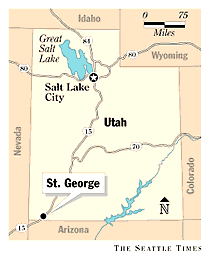When push comes to shove, it's often public appraisers who get moved

There's little incentive for federal bureaucrats to stand in the way of land deals they don't like.
If they argue that a deal is bad for the public, they're likely to be outmatched by resource-rich landowners and consultants. If they persist, they're likely to get pressure from their bosses.
And if they refuse to give in, they may find themselves bounced from the job.
Just ask two Bureau of Land Management appraisers who questioned deals in America's hottest homebuilding markets:
-- Gerald Stoebig, who was the BLM's chief appraiser in Nevada, was swatted down two years ago when he asserted his agency was about to hand a $9 million windfall to the Del Webb Corp. of Phoenix. After being transferred, he quit and is working for another agency.
Today, BLM bosses admit he was right. They want him back, but he's not interested.
"When you stand between somebody and $9 million, they are ruthless," said Stoebig. "There's a lot of underhanded things going on."
-- Jack MacDonald, BLM's chief appraiser in Utah for the past 14 years, was pushed aside when property owners complained about the value he put on land the government was seeking to buy or trade for to create a wildlife preserve near St. George, Utah.
"What I was saying about the value of these lands wasn't what BLM management wanted to hear," MacDonald said.
Del Webb selects appraiser
A Seattle Times investigation of federal land trades found similar instances where private landowners unhappy with appraisals successfully pushed to have appraisers removed from their projects.
"The name of the game when you are dealing with review appraisers is to discredit them however you can," said Stoebig. "It doesn't necessarily have to be true. If he becomes an obstacle, you simply discredit him and hope for a better outcome from the next one."
Del Webb, the company known for its "Sun City" adult residential communities, had been pushing a trade in Nevada for some time, and an earlier effort had been stalled by Congress. Company officials felt Congress owed them one, and some in the U.S. Capitol agreed.
Gary Ryan, the former acting district manager for BLM in Las Vegas, said Nevada Sen. Harry Reid pointedly introduced him to two Del Webb officials and "asked me to put them on the top of the pile and treat them appropriately." Nevada's entire delegation sent a similarly worded letter to the BLM.
Stoebig knew the company had connections: Bruce Babbitt was a Del Webb consultant before he was appointed Interior secretary in 1993. Still, Stoebig expected his office would routinely contract with an appraiser to put a value on both properties in the trade.
To his surprise, BLM's national office dictated that the appraisals be done by a contractor hired by Del Webb.
"I had no input on this," Stoebig said.
Stoebig then learned the private appraiser was using a method discouraged by federal guidelines. Because he was responsible for reviewing the final appraisal, Stoebig insisted on a more acceptable method, taking a strong stand at a March 1996 meeting.
Two weeks later, he was removed from the case. BLM's Washington office appointed a second private company - also nominated by Del Webb - to replace him.
Before the deal closed, however, problems in the appraisal emerged and the Interior Department's inspector general began to look at the deal. BLM appointed yet another appraiser.
This one used the appraisal method Stoebig had recommended, and raised by $9 million the value of the land BLM traded to Del Webb. That meant the taxpayers would get $9 million more land in return.
Del Webb Vice President Scott Higginson said the company accepted the change in order to keep the project on schedule.
BLM Director Pat Shea regrets how Stoebig was treated.
"Quite frankly," said Shea, who was appointed last year and wasn't involved in the case, "the people responsible for not heeding the advice of the Nevada state appraiser are no longer making those decisions."
Asked what he would say to Stoebig now, Shea said he'd ask him to return.
"That's sweet," said Stoebig. "But I don't think there's any substance to that. One just doesn't just up and go back to the agency."
Shea wasn't as charitable toward MacDonald, who still works for him in Utah.
MacDonald's problems began in 1992, when the BLM began acquiring land near the southwestern Utah boomtown of St. George. The land was to provide space for a 60,000-acre preserve to protect the endangered desert tortoise.
At a tense meeting, MacDonald told the owners of the preserve land that their property value would be discounted because of the presence of an endangered species. Dallin Gardner, a local property consultant, said it was an offensive approach - buying property to save the turtles while discounting its value because of the turtles.
An agency legal opinion said MacDonald was right, but BLM took him off the job. Later, Utah Republican Rep. Jim Hansen got Congress to require that the BLM value the parcels as if there were no endangered species there.
Shea still feels that even though MacDonald was right, he was wrong. He accused MacDonald of telling landowners "it was going to be his way or no way."
"And I don't find that attitude to be helpful."

